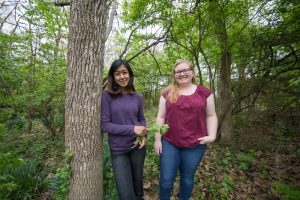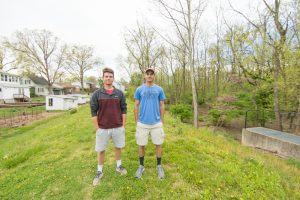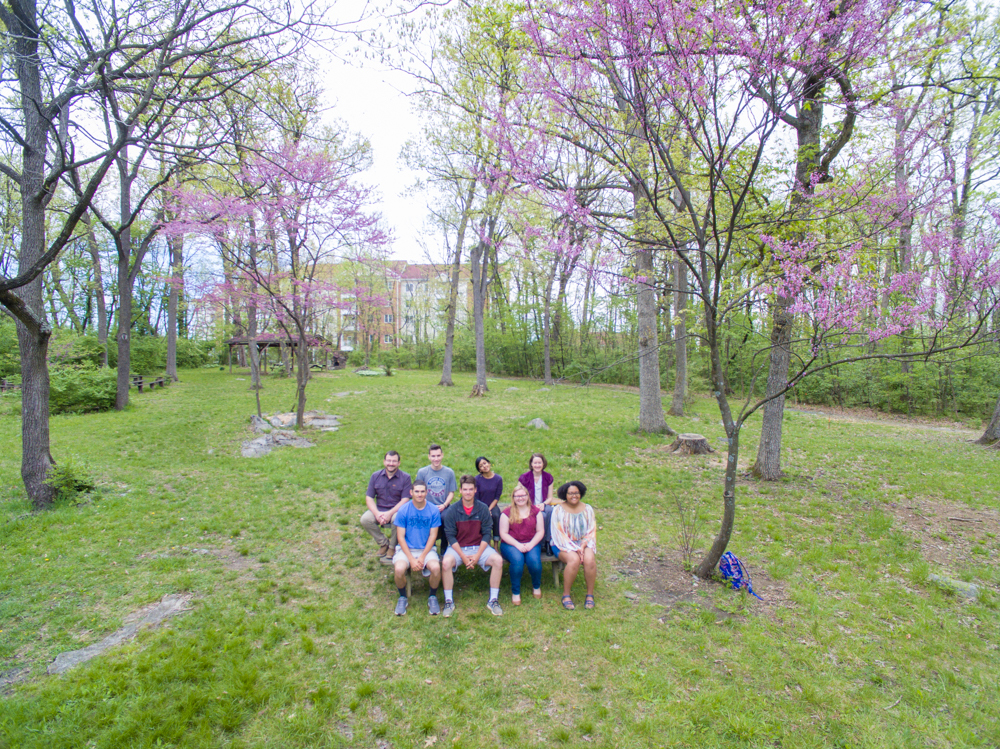At first, Park Woods seemed … pretty.
“Just having this little piece of the woods to come and kind of escape to was so valuable to me,” senior Bekah Mongold said.
She’d come to Eastern Mennonite University from Mathias, West Virginia – “I am very much not a city girl, so living in Harrisonburg was like a culture shock to me,” she said – and the 13-acre woods nestled between the EMU’s Park Wood Apartments and track and the Virginia Mennonite Retirement Community (VMRC) reminded her of her rural home.
However, the more time that Mongold spent in Park Woods – not only for respite but also as part of her spring semester studies – the more she realized that not everything about the woods was as it should – or could – be.
Mongold and five other students taking the spring environmental sustainability capstone course focused their research on the woods, and presented findings and proposals during the EMU Academic and Creative Excellence Festival in April.
“It makes me a little bit sad cause like I know when you when you just walk through, you think, ‘Oh, it’s so green! It’s so pretty!’ And then when you start noticing what is green, it’s like, ‘Oh, that’s maybe not quite as healthy as it should be,’” she said.
The urban forest offers space for immersing oneself in nature, seeking spiritual renewal, learning about the environment and running, hiking and playing. But as Mongold and her classmates learned, it also encapsulates the sometimes-problematic interactions of social and ecological systems.
A live project
Assessing the ecological needs of the wood’s flora and fauna and the broader community was a “live project,” applied social sciences professor Jenni Holsinger said, that involved “real research and real problems that come along with the research process.”

Mongold and fellow senior Nidhi Vinod assessed forest management needs and possibilities in Park Woods, while Ethan Mathews and John Dudley focused on water management, and Victoria Barnes and Xander Silva mapped the stakeholders.
Park Woods is plagued with the invasive bush honeysuckle, plus emerald ash borer, which has caused the death of nearly all of the ash trees there. It also faces frequent flooding from rainfall runoff from elevated surroundings; a diversion dike along its southeast edge retains water in order to prevent flooding of and the dispersion of sediments into the Harrisonburg creek Blacks Run.
Along with the dead ash trees, that flooding threatens or destroys parts of the Park Woods walking path, a winding trail that, along with the fire circle, the pavilion, and, in years past, Park Cabin, is responsible for attracting many of the woods’ stakeholders: VMRC residents, nearby community members, Eastern Mennonite School students, and EMU alumni and student groups. One alumni group, Friends of Park Woods, was organized a few years ago by Paul Lehman and Professor Emeritus Kenton Brubaker and has done much to bring attention to the plight of the woods.
Moving forward
The capstone students pointed to possible interventions in Park Woods, including community volunteers and even goats to remove invasive plant species.

For water management, defining waterways and constructing a wet pond would make the woods both more healthy and attractive, said Mathews, with the pond in particular becoming “a nice place for anybody to come enjoy.”
Even with a limited budget, Barnes said, small improvements – in signage, for example – would promote student use of the woods. And adding bathrooms in Park Cabin would benefit guests, as well.
Intervening, though, takes balance, said Silva.
“I think the biggest thing I learned was finding the line between maximum utility of a space and keeping it a natural ecosystem,” he said. “There are a lot of things that we could do here that would make it a lot more appealing for students and just humans in general, but I also think there are a lot of things that are really special about this place that we really shouldn’t change. … you kind of have to step back and say this space has its own ideas of what it wants to do, and that has to be taken into account.”
“I would like to come back in 10 years and seeing more than just honeysuckle and ivy,” Mongold said.
That may be doable – but other hopes are less likely.
“I would really like to see some ash trees through here,” she added, “but I don’t think that’s possible.”

It is gratifying to see continuing interest of students in the ecological well-being of Park Woods. May their efforts prosper.
For an historical perspective, it may be of interest to go to the EMU Library and dust off a copy of a thesis I wrote 60 years ago for a Master’s degree at Cornell University on the vascular plants and vertebrates of Park Woods.
EMU Community–Thank you for the interest in the welfare of Park Woods. The woodlot there has a great history—but slowly over the past decades nature has taken its route forming a condition not unlike Waterman’s Woods along Waterman Drive a mile away.
When the crowns of a tree lot don’t annually shade the ground under, the prolific growth of understory results–very varied with undesirable vegetation taking over.
You have a daunting task to deal with water control, undesirable undergrowth removal, and overall maintenance—new plantings as necessary. Best wishes on any improvements —It will be work with a capital W.